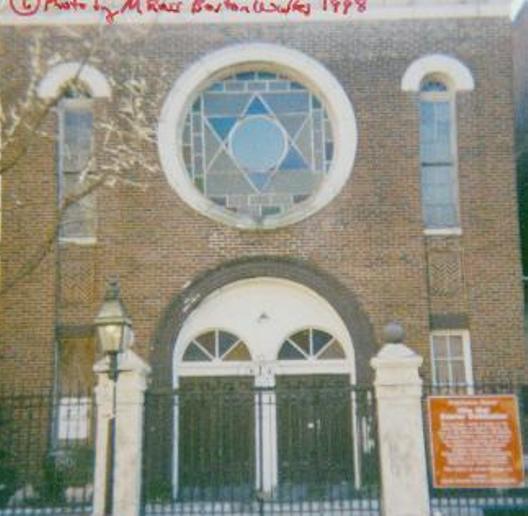 undefined
undefined
 ...How many?
...How many?


BostonWalks |



Question: What's a political mensch?
Answer #1 |
Celebrating 353 Years
|
Now available!The Jewish Friendship Trail Guidebook6
Self-Guided Walking/Bicycling Jewish Boston History Tours Covers
Boston, Brookline, and Cambridge Softcover 198 pages with maps &
b/w photos Print out this |
Now available!
The Ten Commandments Guidebook Ways to Self-Struggle with
Classic Morals In Song, Poetry, and Prose
Covers 10 Commandments Plus One Other! Softcover 153 pages with
practical suggestions pages! Print out this |
![]()
The Synagogues
of
Boston's West End |

Email: Michael Alan Ross
Telephone: 617-489-5020

![]()
The Boston Synagogue, now in a contemporary building at 55 Martha Road in Charles River Park, is located only a few blocks from where its predecessors once stood at 31 North Russell Street and at 24 Wall Street.
Those two shuls were ushered into the West End by a burgeoning Eastern European Jewish immigrant population transitioning from both the North End as well as directly from arrival at customs. By 1895, the Jewish population of the West End matched in numbers the approximately 6.5 thousand Jews of the North End. With much more available housing stock, the West End would welcome another 30+/- thousand Jews over the following 25 years.
Upon their arrival in the West End, many Jews sought out landtsmen from the towns and villages which they had left behind in Eastern Europe. Forming landtsmenshaften, these geographically-based meetings frequently became emotional, social, cultural, educational, political, and, finally, religious mutual support groups. Two of the many landtsmenshaften which evolved into shuls were Anshe Libawitz and Anshe Vilner.
Anshe Libawitz's West End premises at 8 Smith Court, served the congregation from 1898 to 1972. Inside its entryway, a climb up the steeply winding staircase to the former women's section of the shul is a worthwhile effort in order to view the beautiful simplicity of this building. Prior to 1898, the building had a ninety years landmark history as an African-American church, a schoolhouse, and a center of abolitionist activity. Even today, in its present incarnation as a museum of African-American history and without its aron kodish in place, a visitor still can perceive how it was used for 74 years as a shul.

It was the North Russell Street Shul, though, which served as the largest and most prominent, congregation in Boston's West End during the 1st 3 decades of the 20th century. While its building was demolished in the 1950s-60s West End reconstruction, some of Beit HaMidrash HaGadol Beit Yaakov's memorial plaques are preserved in the Boston Synagogue's foyer.
The North Russell Street Shul particularly is remembered by some for its guest cantors and its Jewish holiday parties. One of the many visiting cantors was Yossele Rosenblatt. One Hannukah party attracted 3,000 children.
The Wall Street Shul opened in 1888 and merged with the North Russell Street Shul in 1941. For over 50 years, it served the neighborhood immediately adjacent to today's TD BankNorth Garden, the area at the West end of Causeway Street.
From a similar vantage point today, the Boston Synagogue, with over one hundred members, welcomes all to vibrant West End Jewish services, educational lectures, and holiday celebrations. When you pray in or visit the Boston Synagogue, note one of its unique features: the seating layout which allows a davener either to follow an Orthodox minhag of men and women sitting in separate sections or to follow a Conservative minhag of mixed seating even while all daveners pray together in one prayer service.
Close in time to the establishment of these West End shuls, were the establishment and/or relocation to the West End from the North End of Talmud Torahs and an Ivrio Ivrit Hebrew school - the latter utilizing Hebrew as its spoken, teaching language. By the end of the 1st decade of the 20th century; in addition, there was a Hebrew high school in the West End. Unfortunately, none of the Hebrew school buildings in this section of Boston survived the reconstruction of the West End.


Copyright with a smile from Michael Alan Ross, 1997-2007.
All Rights Reserved.

Now available!The Jewish Friendship Trail Guidebook6
Self-Guided Walking/Bicycling Jewish Boston History Tours Covers
Boston, Brookline, and Cambridge Softcover 198 pages with maps &
b/w photos Print out this |
Now available!
The Ten Commandments Guidebook Ways to Self-Struggle with
Classic Morals In Song, Poetry, and Prose
Covers 10 Commandments Plus One Other! Softcover 153 pages with
practical suggestions pages! Print out this |
Email:
BostonWalks
Telephone:617-489-5020

Chazak Ve-ematz
|
Boston Walks
|
Sing Sense to America
|